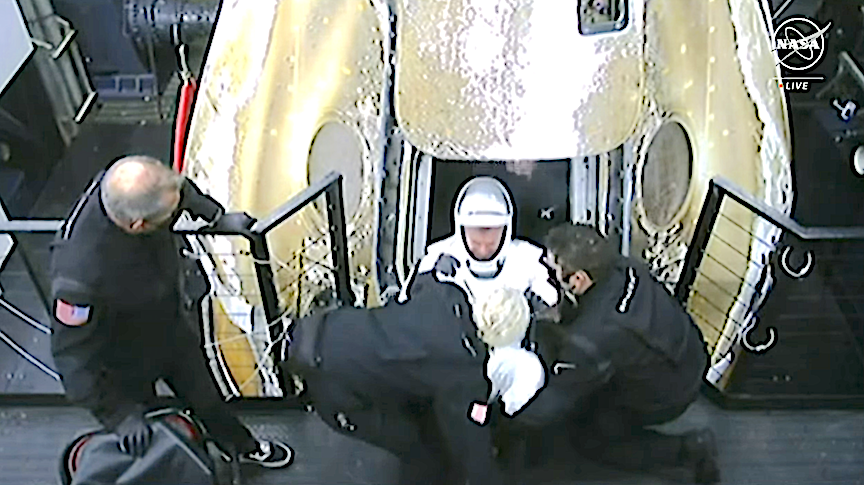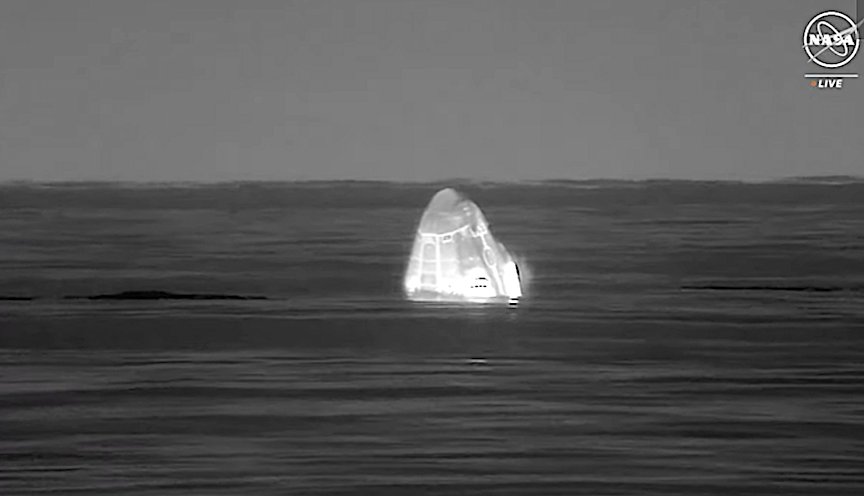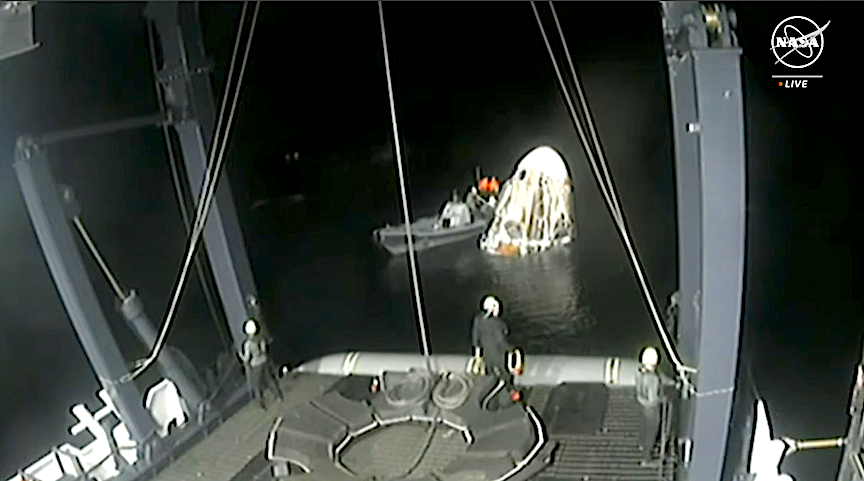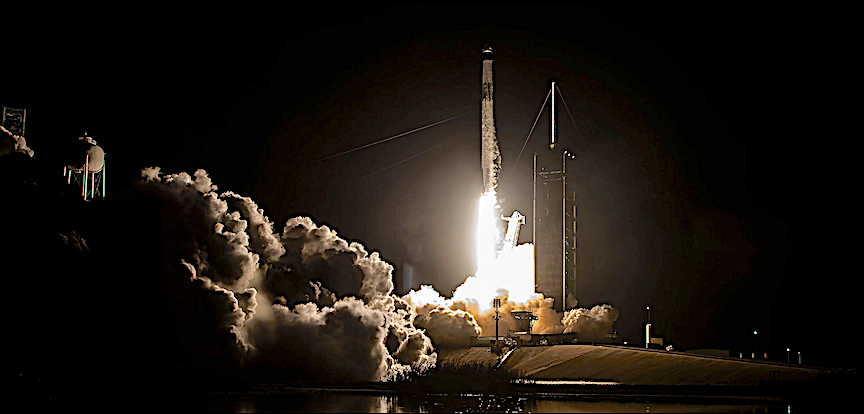
After 199 days in space, Dragon and NASA astronaut Jasmin Moghbeli, ESA astronaut Andreas Mogensen, JAXA astronaut Satoshi Furukawa, and Roscosmos cosmonaut Konstantin Borisov returned to Earth and splashed down off the coast of Florida at 5:47 a.m. ET on Tuesday, March 12, approximately 18.5 hours after Dragon autonomously undocked from the space station on Monday, March 11 at 11:20 a.m. ET.

Falcon 9 launched Dragon and Crew-7 to the orbiting laboratory from Launch Complex 39A (LC-39A) at NASA’s Kennedy Space Center in Florida on Saturday, August 26.
NASA’s SpaceX Crew-7 completed the agency’s seventh commercial crew rotation mission to the International Space Station on Tuesday after splashing down safely in a Dragon spacecraft off the coast of Pensacola, Florida. The international crew of four spent 199 days in orbit.
NASA astronaut Jasmin Moghbeli, ESA (European Space Agency) astronaut Andreas Mogensen, JAXA (Japan Aerospace Exploration Agency) astronaut Satoshi Furukawa, and Roscosmos cosmonaut Konstantin Borisov, returned to Earth splashing down at 5:47 a.m. EDT. Teams aboard SpaceX recovery vessels retrieved the spacecraft and its crew. After returning to shore, the crew will fly to NASA’s Johnson Space Center in Houston.

“After more than six months aboard the International Space Station, NASA’s SpaceX Crew-7 has safely returned home,” said NASA Administrator Bill Nelson. “This international crew showed that space unites us all. It’s clear that we can do more – we can learn more – when we work together. The science experiments conducted during their time in space will help prepare for NASA’s bold missions at the Moon, Mars, and beyond, all while benefitting humanity here on Earth.”
The Crew-7 mission lifted off at 3:27 a.m. Aug. 26, 2023, on a Falcon 9 rocket from NASA’s Kennedy Space Center in Florida. About 30 hours later, Dragon docked to the Harmony module’s space-facing port. Crew-7 undocked at 11:20 a.m. Monday, March 11, to begin the trip home.
Moghbeli, Mogensen, Furukawa, and Borisov traveled 84,434,094 miles during their mission, spent 197 days aboard the space station, and completed 3,184 orbits around Earth. The Crew-7 mission was the first spaceflight for Moghbeli and Borisov. Mogensen has logged 209 days in space over his two flights, and Furukawa has logged 366 days in space over his two flights.
Throughout their mission, the Crew-7 members contributed to a host of science and maintenance activities and technology demonstrations. Moghbeli conducted one spacewalk, joined by NASA astronaut Loral O’Hara, replacing one of the 12 trundle bearing assemblies on the port solar alpha rotary joint, which allows the arrays to track the Sun and generate electricity to power the station.

The crew contributed to hundreds of experiments and technology demonstrations, including the first study of human response to different spaceflight durations, and an experiment growing food on the space station.
This was the third flight of the Dragon spacecraft, named Endurance. It also previously supported the Crew-3 and Crew-5 missions. The spacecraft will return to Florida for inspection and processing at SpaceX’s refurbishing facility at Cape Canaveral Space Force Station, where teams will inspect the Dragon, analyze data on its performance, and process it for its next flight.
The Crew-7 flight is part of NASA’s Commercial Crew Program and its return to Earth follows on the heels of NASA’s SpaceX Crew-8 launch, which docked to the station March 5, beginning another science expedition.
The goal of NASA’s Commercial Crew Program is safe, reliable, and cost-effective transportation to and from the International Space Station and low Earth orbit. This already is providing additional research time and has increased the opportunity for discovery aboard humanity’s microgravity testbed for exploration, including helping NASA prepare for human exploration of the Moon and Mars.
SpaceX’s Dragon successfully departs the ISS to return NASA’s Crew-7 astronauts back to Earth

Monday, March 11 at 11:20 a.m. ET SpaceX and NASA witnessed the Dragon autonomously undocked from the International Space Station. After performing a series of departure burns to move away from the space station, Dragon conducted multiple orbit-lowering maneuvers, jettison the trunk, and will re-enter Earth’s atmosphere for splashdown off the coast of Florida almost 19 hours later at approximately 5:50 a.m. ET on Tuesday, March 12.



Aboard the spacecraft will be Crew-7 NASA astronaut Jasmin Moghbeli, ESA astronaut Andreas Mogensen, JAXA astronaut Satoshi Furukawa, and Roscosmos cosmonaut Konstantin Borisov, who flew to the space station on Dragon when Falcon 9 launched the spacecraft from Launch Complex 39A (LC-39A) at Kennedy Space Center in Florida on Saturday, August 26.

NASA/Joel Kowsky
Crew-7 completed a 6-month science mission living and working aboard the microgravity laboratory to advance scientific knowledge and demonstrate new technologies for future human and robotic exploration missions as part of NASA’s Moon and Mars exploration approach, including lunar missions through NASA’s Artemis program.
